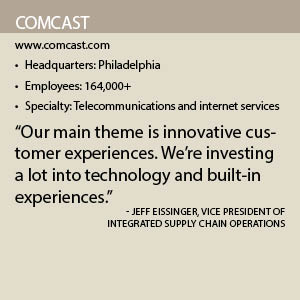Comcast
Comcast focuses on providing innovative built-in experiences and self-install products for its customers.
by Kat Zeman
As technology moves forward and changes with increasing speed, many tech companies face new challenges – especially when it comes to supply chain. “As technology advances, a product’s lifecycle becomes shorter and shorter,” says Jeff Eissinger, vice president of integrated supply chain operations. “So from a supply chain perspective, our approach to inventory has become leaner and more focused.”
Comcast, along with a growing number of electronics manufacturers and service providers, is focusing on reverse logistics, a series of activities required to retrieve a used product from a customer and either dispose of it or reuse it.

But Comcast is focusing on making its products easy to install and manage, therefore decreasing the likelihood of being returned. “One of the largest supply chain improvements we’ve had is in self-service and self-install,” Eissinger says. “Our customers want to be able to manage their time at home and do things when it’s convenient for them.”
Fast and Easy
One of Comcast’s newest easy-to-install products is the xFi Advanced Gateway modem and router. Comcast describes the modem as the most advanced device it’s ever made. It became available in December in every market where Comcast offers gigabit internet.
The modem’s biggest advantage is its speed, but the product was also designed for people with varying levels of tech literacy. “You don’t have to be a technology expert to install and enjoy our products and services,” Eissinger says.
As the name implies, every xFi Advanced Gateway comes packaged with xFi, Comcast’s personalized Wi-Fi experience. The device has a simple digital dashboard for customers to set up their home Wi-Fi network, find their password, see what devices are connected, troubleshoot issues, set parental controls and even pause Wi-Fi access on their home network during dinner or bedtime.
Setting up an xFi Advanced Gateway is as simple as plugging it in, scanning a QR code with the xFi app and clicking through a few simple prompts. Once online, customers have unprecedented control over their home Wi-Fi network, with the ability to set profiles for every member of the household, assign devices and decide what devices connect and when. The product is now available to more than 10 million homes throughout the United States.
Built-In Experiences
Comcast has paired up with both Netflix and Google to provide built-in experiences at faster speeds for its customers. “Our main theme is innovative customer experiences,” Eissinger says. “We’re investing a lot into technology and built-in experiences, like YouTube and Netflix.”
In September 2017, Comcast and Google launched YouTube on the Xfinity X1 entertainment operating system, Comcast’s one-of-a-kind interactive TV experience. It gives viewers easy access to YouTube’s vast online video collection along with live, on demand, DVR and other web programming that is already included with an Xfinity TV subscription. YouTube content is accessible via the X1 voice remote and YouTube videos are featured throughout Xfinity on Demand.
YouTube’s online videos are featured throughout the Xfinity On Demand menu and available in the YouTube app. It provides easy access to trending videos and complements Comcast’s existing movie, TV show, music, news and other content on X1 and supplementing thematic destinations.
In 2016, Comcast teamed with Netflix to launch the service on its X1 devices. It gives Xfinity X1 customers with Netflix subscriptions the ability to easily browse and access Netflix TV shows and movies along with the Xfinity content included in their subscription.
Comcast executives say that the partnership with Netflix gives its customers access to content in a way that has never been done before. The experience is designed to be seamless and intuitive, allowing viewers to search and watch tens of thousands of movies and shows with the sound of their voice. The fully integrated platform means that customers will no longer need to change inputs or juggle remotes, moving seamlessly between the Netflix app and their cable service.